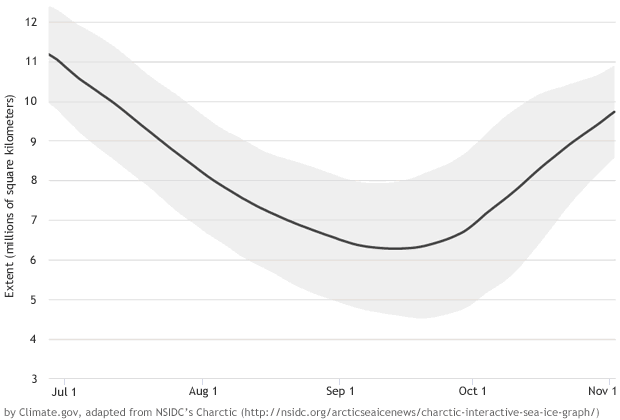Arctic sea ice is one of the grandaddies of climate indicators. And this grandaddy isn’t doing so good these days.
This year’s sea ice extent has bottomed out as the second lowest on record, according to the National Snow and Ice Data Center. It continues a troubling trend as rapidly warming air and water eats away at the briny, frozen mantle on the top of the planet.
This year has been exceptional by many standards. March saw the lowest sea ice maximum ever recorded followed by a string of record low months. The Northwest Passage opened up, allowing a luxury cruise ship to travel from Anchorage to New York. And a freak storm in August turned ice thin and brittle near the North Pole.
Satellites show the last seven months of sea ice and reveal its steep decline this year. The late August breakup is particularly notable. Grist’s Amelia Urry compared the texture of sea ice near the North Pole to curdled milk or an exploded pillow (I’d go with broken glass personally, but to each their own).
This year’s nadir tied 2007 for the second lowest Arctic sea ice extent on record, trailing only 2012. Sea ice extent was 1.77 million square miles, which is 630,000 square miles below average. That’s essentially an Alaska-size chunk of ice missing.
The yearly minimum came a bit early this year, but overall the trend is toward later sea ice minimum. That’s largely because of rising temperatures, which are increasing the number of (relatively) warm days in the Arctic. The minimum occurs on average about five days later now than it did at the start of the satellite record in 1979.
The stats, beyond single years, all tell the grim story of disappearing ice. All 10 of the smallest sea ice extents on record have occurred since 2005. In the nearly four decades of satellite monitoring, sea ice has disappeared at a clip of 13.4 percent per decade.
This year’s cracked ice also continues a troubling trend of disappearing old ice. Though some of that ice will refreeze together this winter, some has disappeared for good and new ice will be left to fill in the gaps. That’s like putting a piece of paper over a hole in your wall, though.
Young ice tends to be weaker and thinner and thus more susceptible to summer melt. It’s a trend that’s already happening. Ice younger than four years comprised 97 percent of all Arctic sea ice in 2015 compared to 80 percent in 1985.
Most of what we tend to talk about with Arctic sea ice comes courtesy of satellites, since they’re the most reliable way to monitor such a remote region. Recent research has reconstructed Arctic sea ice data back to 1850 using old ship logs, airplane surveys, and military records, among other sources, to provide a longer record than satellite data (though it does come with a little bit more uncertainty). What is certain is that there’s nothing in modern history like the recent string of low Arctic sea ice years we’ve seen.
Sea ice has declined precipitously across the Arctic, but particularly in the Beaufort and Chukchi Sea regions. In the coming decades, sea ice extent is only likely to keep shrinking and could reshape the region’s ecology, economy, and ways of life for the plants, animals, and people that call the region home.




